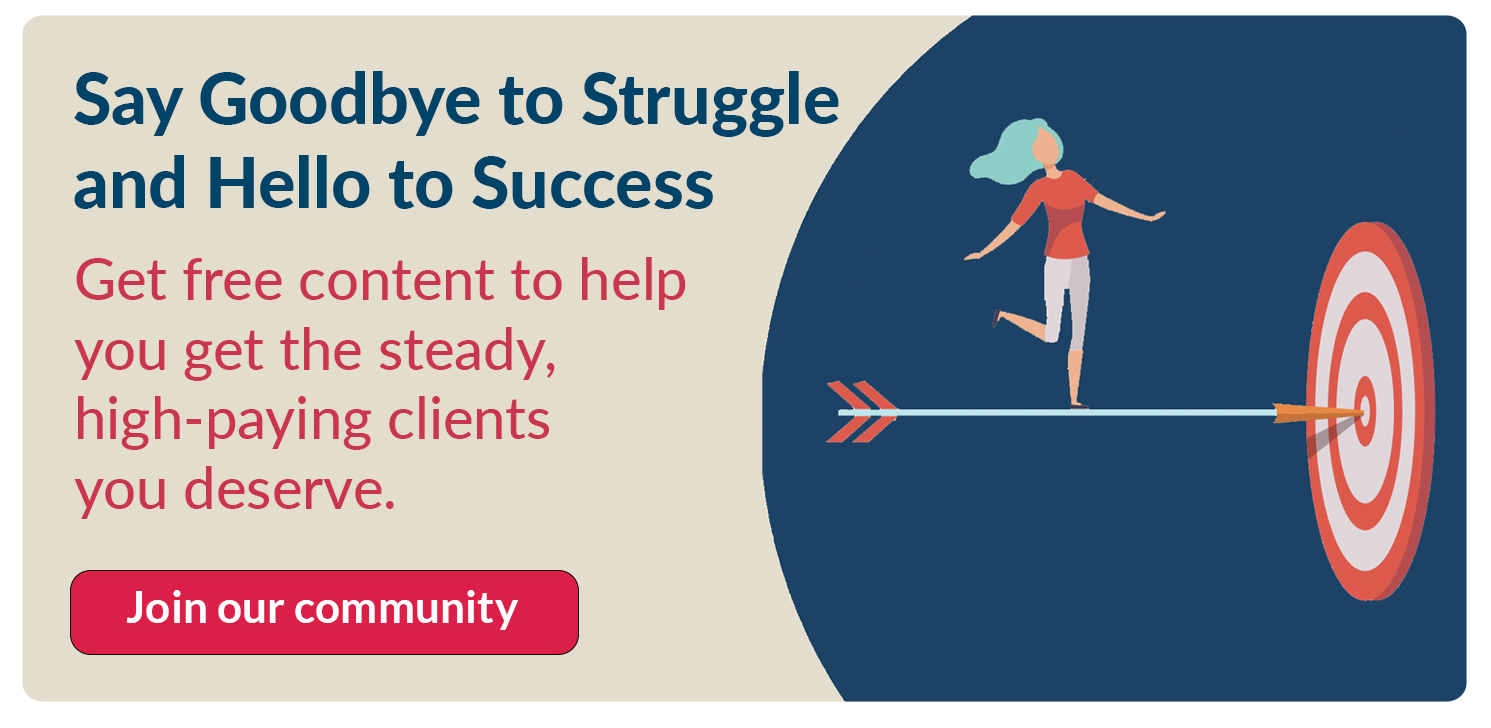Goals for Freelance Success: The Ultimate Guide

Whether you’re just getting started or are an experienced freelancer, goals help you build a stable, successful freelance business. And if you’re already successful, setting your goals will help you be more strategic about the work you do and the clients you work with.
Here at The Mighty Marketer, I’ve been helping freelancers learn how to grow their businesses since 2014. In this guide, I give you a proven 6-step process for setting and achieving your goals:
Let’s get started!
In This Guide
- Set SMART Goals
- Break Your Goals Down into Actionable Steps
- Get Started
- Build Your Momentum
- When You Fall Behind, Get Back on Track
- Next Steps
1. Set SMART Goals
 The right type of goal for freelance success is SMART:
The right type of goal for freelance success is SMART:
- Specific
- Measurable
- Attainable
- Relevant
- Time bound.
Specific: Setting a specific and attainable goal is really important. It’s easier to stick with and achieve a goal that’s specific because you have something concrete to work towards.
Measurable: If you don’t measure what you’re doing, you don’t know if you’re making any progress. Measure whether you’re spending your time doing things that are important to your freelance business.
Attainable: And if your goal is too big, you’ll get discouraged and stop trying. So it has to be attainable.
Relevant: Your goal also needs to matter to you (be relevant). If it doesn’t, you won’t want to work to achieve it.
Time bound: Just like you have deadlines for your client work, you need a deadline for your goal. Otherwise, working on your goal will get lost behind everyday tasks.
Examples of goals for freelancers
Here are some examples of goals that do and don’t work.
Dumb goals for freelancers:
“Make more money.”
“Get more clients.”
Goals like “Make more money.” don’t work because if you make $1 more, then you’ve achieved your goal. But you’re not going to build your freelance business by making $1 more.
SMART goals for freelancers:
“Make $20,000 more in [YEAR] than in [YEAR] by getting 3-4 new clients.”
“Make $20,000 more in [YEAR] than in [YEAR] by getting more business from current clients.”
“Diversify my business by getting 4 to 6 different types of clients by December 31, [YEAR].”
Choose annual or 100-day goals
Annual goals work best for most freelancers. Some experts recommend 100-day goals. If you need to build your business fast and are motivated and ready to work hard, try 100-day goals.
If you’re setting annual goals, set 1 to 3 goals.
Focus on the results of your year-end review
Doing a year-end review will help you set the right goals. My simple year-end review will help you assess:
- What went right?
- What can I improve?
- What’s next?
Use your answer to What’s Next? to set your goal(s).
While people usually set goals at the end of one year for the next, you can set them at any time of year. And you can also do a year-end review at any time.
FREE SMART GOALS WORKSHEET
Use my free SMART goals worksheet to set and achieve goals for freelance success.
2. Break Your Goal(s) Down into Actionable Steps
 An annual (or 100-day) goal, even when it’s SMART, can be scary and overwhelming.
An annual (or 100-day) goal, even when it’s SMART, can be scary and overwhelming.
So break your big goal(s) down into several quarterly mini-goals and the monthly actions you’ll take to achieve each mini-goal.
Mini-goals are smaller and easier to achieve than an annual (or 100-day) goal. If you’re using 100-day goals, set monthly or 10-day mini goals, depending on how hard you’re willing to work.
Actions are even smaller. They’re easy to achieve and can take as little as a few minutes.
Near the end of each quarter, one of the actions is to assess your progress and make any changes you need to make to you annual goal, mini-goals, and actions.
Example of a mini-goal and actions
Say that your annual goal is:
“Make $20,000 more in [YEAR] than in [YEAR] by getting 2-4 new clients by year-end.”
Your mini-goals and actions for the first quarter of the year might look like this:
Quarterly mini-goals for the [XX quarter in YEAR]:
-
-
- Optimize my LinkedIn profile.
- Volunteer for 1 professional association.
- Research 70 new prospects, with a focus on [TYPE OF CLIENTS YOU WANT TO WORK WITH] in the [INDUSTRY].
- Send 10 direct emails.
-
Monthly actions:
JANUARY:
-
-
- Create a compelling, client-focused LinkedIn profile.
- Explore volunteer opportunities and contact the association to volunteer.
- Research 35 prospects.
-
FEBRUARY:
-
-
- Continue to volunteer.
- Research 35 more prospects.
- Send 5 direct emails this month.
-
MARCH:
-
-
- Continue to volunteer.
- Send 10 direct emails this month.
- Late March: Review and assess progress toward goal
-
Your freelance success plan
Together, your SMART goal(s), mini-goals, and actions become your plan for freelance success. And having a plan makes you 2 to 3 times more likely to stick to your goal(s).
3. Get Started
 Getting started is the hardest part of doing anything that’s new or difficult. Working on goals is especially hard, because it takes so long to see the results—and our brains are wired for immediate gratification.
Getting started is the hardest part of doing anything that’s new or difficult. Working on goals is especially hard, because it takes so long to see the results—and our brains are wired for immediate gratification.
Set your goal(s) and quarterly mini-goals
Get your annual (or 100-day) goal(s) down on paper. It has to be SMART, but it doesn’t have to be perfect. Then set your quarterly mini-goals. You can revise or even change a goal or mini-goals later if you need to.
Set and start taking actions
Now you’re ready to choose and start taking actions. Each action you achieve will help you build momentum—and momentum will make it easy to keep moving toward achieving your goal(s).
Example
Let’s use the sample goal from earlier:
“Make $20,000 more in [YEAR] than in [YEAR] by getting 2-4 new clients by year-end.”
Part of the mini-goal for the first quarter of the year is to research 70 prospects. That sounds like a lot of work.
But when you break this down into monthly actions, researching 30 prospects over a month is very doable. If you break that down further into researching 7-8 prospects each week, you’ve got an action that you can do in about 2 hours over a week.
4. Build Your Momentum
 Each action you take helps you build momentum. And momentum helps you be more effective and more efficient. It also helps you overcome challenges.
Each action you take helps you build momentum. And momentum helps you be more effective and more efficient. It also helps you overcome challenges.
By taking the right actions consistently, you start to focus on what matter most. Consistent action makes it easier to keep taking consistent actions.
Take the actions that lead to results
Actions are powerful because we have total control over whether we achieve them.
Let’s use the sample action above of sending 5 direct emails a month. You have total control over whether you do this. You don’t have control over whether clients hire or contact you about freelance work based on your direct emails. And this usually takes time, since clients rarely need our help when we first reach out to them.
So if you focus on your actions, you’re building momentum to keep taking the right actions consistently. And taking the right actions consistently will eventually lead to the results you want: a stable, successful freelance business filled with steady, high-paying clients.
5. When You Fall Behind, Get Back on Track
 If you’ve fallen behind on your goal(s), mini-goals, or actions, it’s okay.
If you’ve fallen behind on your goal(s), mini-goals, or actions, it’s okay.
Most of us do fall behind and many people give up entirely. One month after setting a goal, just 58.4% of people are still working on it and 6 months later, only 44.8% are still trying, according to Statistic Brain.
Just don’t give up. Get back on track quickly.
Keep working on your goal(s)
Goals are not “all or nothing.” If you set a goal and later realize that it’s just not doable now, change it or postpone it. If you realize that your goal is no longer a priority, drop it and set a goal based on what matters most to your freelance business now.
Then get back to taking the consistent actions that will help you build a stable, successful freelance business.
Next Steps

Congratulations on making it to the end of this guide! By now you should understand how goals help you build a stable, successful freelance business. And you have a proven process for setting and achieving your goals(s):
- Set SMART Goals
- Break Your Goal(s) Down into Actionable Steps
- Get Started
- Build Your Momentum
- When You Fall Behind, Get Back on Track
I hope that by now you feel confident enough to set and start working on goals for your freelance business, so that you can get the steady, high-paying clients you deserve.
Ready to be the freelance success you were meant to be?
If you’re ready to take the next step, download one of my free ebooks. It will help you develop the compelling, client-focused marketing you need to build a stable, successful freelance business.



Learn More About Goals for Freelance Success
FREE SMART GOALS WORKSHEET
Use my free SMART goals worksheet to set and achieve goals for freelance success.
Grab your worksheet.Ready to Become the Freelance Success You Were Meant to Be?

Get on the VIP list for early access to the course.
Email themightymarketer@comcast.net and type VIP List in subject.